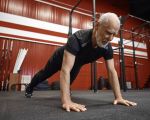Weekly Fitness Plans for Muscle Building
- -The Importance of a Consistent Fitness Plan
- -Setting Realistic Muscle Building Goals
- -Structuring Your Weekly Fitness Plan for Maximum Muscle Gain
- -Incorporating Different Types of Exercises for Muscle Building
- -Rest and Recovery: Key Components of a Fitness Plan
- -How Fitness Can Help You Achieve Your Muscle Building Goals
The Importance of a Consistent Fitness Plan
When it comes to muscle building, consistency is one of the most important factors for success. Many people start a workout routine with enthusiasm, but they often lose motivation after a few weeks or fail to stick to a structured plan. However, building muscle isn’t just about lifting weights at random – it requires a consistent, well-designed fitness plan that incorporates various elements to stimulate muscle growth and recovery. A well-crafted weekly fitness plan for muscle building helps you stay on track, measure progress, and ensure that you're targeting all the right muscle groups effectively.
Muscle growth, or hypertrophy, is a gradual process that involves pushing your muscles beyond their normal capacity and then allowing them to recover and grow stronger. This process requires a balance of resistance training, adequate nutrition, and proper rest. Without a structured approach, you might not see the results you're hoping for. That's why creating a weekly fitness plan designed for muscle building is crucial. Let's dive into the key components that will help you get the most out of your workouts.
Setting Realistic Muscle Building Goals
Before starting your weekly fitness plan for muscle building, it's important to set realistic and achievable goals. Whether you're looking to increase your strength, size, or endurance, understanding what you want to achieve will help guide your workouts and keep you motivated.
For beginners, focusing on strength and learning proper form should be the priority. As you progress, you can shift towards increasing muscle mass. Setting goals like "Increase bench press by 10 pounds" or "Gain 5 pounds of muscle in the next two months" can give you clear benchmarks to aim for. It's also essential to monitor your progress by tracking your workouts, nutrition, and overall physical condition.
Additionally, it's important to acknowledge that muscle building takes time. Don’t expect drastic results overnight. A realistic timeline for visible muscle growth is typically around 6-8 weeks, depending on your starting point and the intensity of your training regimen. Setting small, achievable milestones can keep you motivated and help prevent discouragement along the way.
Structuring Your Weekly Fitness Plan for Maximum Muscle Gain
A successful weekly fitness plan for muscle building must be structured to target all major muscle groups while ensuring that you're getting the right balance of intensity and recovery. Below is an example structure that you can incorporate into your weekly workout routine:
- Day 1 - Chest and Triceps: Focus on compound movements like bench press, push-ups, and incline dumbbell presses. Finish off with tricep dips and cable pushdowns to target the triceps.
- Day 2 - Back and Biceps: Include exercises like pull-ups, rows, and lat pulldowns for your back. For your biceps, incorporate barbell curls, dumbbell curls, and concentration curls.
- Day 3 - Legs and Core: Leg workouts should include squats, lunges, and deadlifts for the lower body. Don't forget to work your core with exercises like planks, leg raises, and Russian twists.
- Day 4 - Shoulders and Traps: Focus on overhead presses, lateral raises, and front raises. Shrugs are essential for building your traps and upper back muscles.
- Day 5 - Full Body Circuit: On the fifth day, combine full-body exercises such as kettlebell swings, deadlifts, clean and press, and medicine ball slams to enhance muscle endurance and overall strength.
This structure allows for sufficient time to recover between workouts while hitting all major muscle groups. Each workout should last around 45 minutes to an hour, including a warm-up and cool-down period. You should aim for 3-4 sets of 8-12 repetitions per exercise, adjusting the weight as needed to continue challenging your muscles. Remember to progressively overload your muscles by increasing the weight or reps over time to continue stimulating growth.
Incorporating Different Types of Exercises for Muscle Building
Incorporating a variety of exercises into your weekly fitness plan is key to ensuring balanced muscle development. This not only targets different muscle fibers but also prevents plateauing and boredom. Here are a few exercise types you should consider integrating into your routine:
- Compound Exercises: These are exercises that engage multiple muscle groups at once, like squats, deadlifts, and bench presses. They’re highly effective for building muscle and strength.
- Isolation Exercises: These exercises focus on one muscle group at a time, like bicep curls or leg extensions. They’re excellent for targeting specific muscles and improving definition.
- Bodyweight Exercises: Bodyweight exercises such as push-ups, pull-ups, and planks are great for improving muscle endurance and can be done anywhere.
- Cardio: While cardio isn't the focus of a muscle-building plan, incorporating a small amount of low-impact cardio (such as walking or swimming) can help improve heart health and recovery.
By mixing these different types of exercises, you’ll keep your workouts interesting and target all aspects of muscle growth. Each type has its unique benefits, and alternating between them can help you avoid plateaus and continue making progress.
Rest and Recovery: Key Components of a Fitness Plan
Rest and recovery are just as important as the workout itself when it comes to muscle building. After each intense workout, your muscles need time to repair and grow. Overtraining can lead to injury, burnout, and stagnation in your muscle-building progress.
Incorporate at least one or two rest days into your weekly plan. On rest days, you can focus on light activity, such as walking or stretching, to promote blood flow and aid recovery. Additionally, sleep is crucial for muscle recovery, as this is when the body produces the most growth hormone. Aim for 7-9 hours of sleep each night to maximize muscle repair and growth.
Another key aspect of recovery is nutrition. Consuming protein after a workout can help with muscle repair, while carbohydrates are essential for replenishing glycogen stores. A balanced diet rich in whole foods will support your muscle-building efforts in the long run.
How Fitness Can Help You Achieve Your Muscle Building Goals
Fitness is the cornerstone of any muscle-building program. Whether you're a beginner or an advanced lifter, consistency and commitment to your weekly fitness plan are essential for success. Additionally, supplementing your workouts with proper nutrition, recovery, and lifestyle habits will significantly enhance your results.
If you’re looking to take your muscle-building efforts to the next level, consider getting guidance from professionals. Fitness offers various training programs, equipment, and expert advice that can support you in your journey to building muscle. Whether you're in need of high-quality gym gear or personalized workout plans, Fitness can help you find the right products and services to enhance your fitness experience and muscle-building progress.








